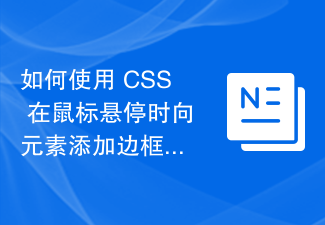Found a total of 10000 related content

The difference between mouseover and mouseenter in jQuery events
Article Introduction:In our pages, mouseover and mouseout events are often used to add better rendering effects to the page. However, if the element that triggers the mouseover event has child elements, it will cause a flickering effect, which is very uncomfortable to watch. This is because mouseover and mouseout will trigger regardless of whether the mouse pointer passes through the selected element or its sub-elements. The mouseenter and mouseleave events will only be triggered when the mouse pointer passes through the selected element.
2017-06-28
comment 0
1410

What dynamic effects can JavaScript achieve?
Article Introduction:JavaScript is a high-level programming language widely used in web development. It can add various dynamic effects to the website to improve user experience and interactivity. In this article, we will explore several dynamic effects implemented in JavaScript. 1. Mouse hover effect Mouse hover effect can make users feel that the website is more vivid. This effect is often used in menu bars, links, buttons, etc. In JavaScript, the mouseover effect can be controlled through the mouseover and mouseout events. When the mouse moves to the
2023-04-23
comment 0
1403


Tips and methods to use CSS to achieve blur effects when the mouse is hovering
Article Introduction:Tips and methods for using CSS to achieve blur effects on mouse hover. In modern web design, dynamic effects are crucial to attracting users’ attention and improving user experience. Mouseover effects are one of the common interactive effects that can make a website more vivid and eye-catching. This article will introduce how to use CSS to achieve blur effects when the mouse is hovering, and give specific code examples. Use the CSS filter attribute to set the blur effect. In CSS3, we can use the filter attribute to achieve various image effects.
2023-10-20
comment 0
685

jquery mouse over image to reverse text
Article Introduction:With the development of web pages, dynamic effects have become an important part of design, and among these effects, the effect of images and text appearing alternately is particularly common. This article introduces a jQuery-based implementation method for reversing text on mouse-over images. 1. Implementation principle: Place pictures and text in the same element container, and achieve alternate display of pictures and text by controlling CSS styles. When the mouse is hovering, jqury is used to reverse the images and text in the container and modify the CSS style to achieve dynamic effects. 2. Implementation steps 1. Create HTML structure. First, create an
2023-05-08
comment 0
584

How to add effects in fl studio Three ways to add musical instruments in fl studio
Article Introduction:Type 1: Drag the instrument from the file browser to the channel rack. In the file browser, click the third icon above, and all available instruments (Generators) and Effects (Effects) will be displayed in the file browser. The [Installed] folder contains the third-party instruments and effects you installed. Second type: Use PluginPicker to click the penultimate button on the shortcut panel to open the pluginpicker. You will see all the instruments and effects (the shortcut key is F8), which is a bit similar to the launchpad in the Apple system, which is quite cool. The third method: click the plus sign below the channel rack and your instrument list will pop up.
2024-06-08
comment 0
956

Detailed graphic explanation of the difference between mouse events CSS:hover and JS:mouseover
Article Introduction:In order to make the page more attractive at work, front-end developers often add mouse movement in and out effects to the page. There are generally two methods for setting the mouse move in and out. One is to simply use the hover pseudo-class in CSS, and the other can use the DOM events in JS, namely onmouseover and onmouseout. Next, this article will tell you about the difference between CSS pseudo-class hover and JS mouse event mouseover.
2018-09-15
comment 0
25185

How to optimize web page performance
Article Introduction:Web page performance optimization 1. Image optimization 1.1 Styles instead of images For example: translucency, rounded corners, shadows, highlights, gradients, etc. These effects are perfectly supported by mainstream browsers, and for those low-end browsers, we will not completely abandon them. "Progressive enhancement" is a good solution. 1.2 Sprite CSS Sprites combine background images such as icons or buttons of the same type into one large image to reduce page requests. 1.3 Font Icon Icon Font, make the icon into a font file. The advantage is that the icon supports multiple sizes and
2017-09-25
comment 0
2053

How to write events in jquery
Article Introduction:jQuery is a popular JavaScript library that plays an important role in our web development. Among them, events are important interactive elements on the page and can be the key to achieving various interactive effects. So, in this article, we will discuss in depth how to write events in jQuery. 1. Binding events In jQuery, you can use the .on() method to bind events. This method requires at least two parameters. The first parameter is the event type, such as click, mouseover, keydown, etc., and the second
2023-05-25
comment 0
913

How to use opacity in css
Article Introduction:Usage of opacity in CSS: What is opacity? The opacity attribute controls the opacity of the element, that is, the degree to which the element transmits light. The value range is 0 (completely transparent) to 1 (completely opaque). How to use opacity? The syntax of the opacity attribute is: opacity: value; value can be a number between 0 and 1 or the inherit/initial keyword. Applications of opacity: The opacity attribute is widely used in web design, such as creating transparent backgrounds, fade-in/fade-out effects, overlays, mouseover effects, and image blending.
2024-04-28
comment 0
1044

Basic steps for setting graphic styles in AI
Article Introduction:Open ai and create a new blank document. Use the Ellipse tool in the left toolbar to draw a circle for demonstration purposes. Click the [Window] option above, and then in the drop-down menu, you can see that there is an item called [Graphic Style]. Click [Graphic Style], and the [Graphic Style] setting box will appear, where you can choose different styles. For example, after selecting a circle, in the [Graphic Style] dialog box, click one of the [3D] styles, and the circle will become that style. To add artistic effects, you can click the icon in the lower left corner and click [Artistic Effects] in the menu, and the [Artistic Effects] dialog box will pop up. Click on one of the artistic effects, and the circle will become this style. Other effects can also be added in this way.
2024-04-23
comment 0
639

vue mouse move into remove event
Article Introduction:Vue.js is a very convenient and easy-to-use front-end framework. It is based on the MVVM model, and it is very easy to achieve dynamic effects on the page during the development process. In Vue.js, mouse events are very common, and mouse in and out events (mouseover and mouseout) are also widely used. Let's learn how to use mouse move in and remove events in Vue.js. 1. Mouse enter event When the user's mouse moves over an element, Vue.js will trigger the mouseenter event. exist
2023-05-08
comment 0
3773

When to use pseudo elements
Article Introduction:Pseudo elements are used when inserting content, creating decorative effects, changing the style of elements, and creating animation effects. Detailed introduction: 1. Insert content. You can use pseudo elements to insert content before and after the element. This is very useful for some special design needs. You can use the ::before pseudo element to insert an icon or a piece of text in front of an element, so that you can Avoid adding extra tags in HTML to make the code more concise and easier to maintain; 2. Create decorative effects. Pseudo elements can also be used to create some decorative effects and so on.
2023-10-10
comment 0
619

How to add a border to an element on mouseover using CSS?
Article Introduction:CSS provides developers with the powerful ability to customize and style their pages the way they want. One of the many features it offers to enable this level of customization is the ability to add interactivity to web elements. Hover effects can provide a more dynamic user experience. By applying a border to an element on mouseover, users get a visual cue that they have interacted with the element. Syntax selector:hover{/*CSSpropertyandvaluestobeappliedonhover*/}: Hover selector The :hover selector in CSS is used to apply a style to an element when the mouse cursor is hovering over it. Here, the selector refers to the
2023-09-15
comment 0
1537

How to batch color in vsco How to batch color in vsco
Article Introduction:How does vsco batch color adjustment (vsco batch color adjustment method), how to operate it specifically, follow the editor to see. Open the VSCO software and first adjust a picture to the effect you want. Then select the adjusted picture and click the second icon below ~ click the COPIED copy icon to copy. In this way, the effect adjusted on the previous picture is copied~ Select another picture, and then click the second icon below~ Select PASTE to paste the effect, and paste the effect~ In this way, you will find that the picture is instantly toned~ (If If you are still not satisfied, you can make fine adjustments~), be careful not to click COPY~As shown in the figure, of course you can also select multiple pictures at the same time, select the second icon~Select PASTE to copy and paste batch effects~ Section
2024-06-17
comment 0
1140



















